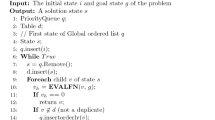Abstract
Analogical planning provides a means of solving engineering problems where other machine learning methods fail. Unlike many machine learning paradigms, analogy does not require numerous previous examples or a rich domain theory. Instead, analogical planners adapt knowledge of solved problems in similar domains to the current problem. Unfortunately, the analogical planning task is an expensive one. While the process of forming correspondences between a known problem and a new problem is complex, the problem of selecting a base case for the analogy is virtually intractable.
This paper addresses the issue of efficiently forming analogical plans. The Anagram planning system is described, which takes advantage of the massively parallel architecture of the Connection Machine to perform base selection and map formation. Anagram provides a tractable solution to analogical planning, with a complexity that is sublinear in the size of the plans.
This paper describes the Anagram system and its parallel algorithms. The paper also presents theoretical analyses and empirical results of testing the system on a large database of plans from the domain of automatic programming.
Similar content being viewed by others
References
B. Falkenhainer, K.D. Forbus, and D. Gentner, “The structure-mapping engine: Algorithm and examples”, Technical Report UIUCDCS-R-87–1361, University of Illinois, Urbana-Champaign, July 1987.
R. Greiner, “Learning by understanding analogies”, in Analogica, edited by A. Prieditis, Los Altos, CA: Morgan Kaufmann Publishers, pp. 1–36, 1988.
B. Adelson, “Cognitive research: Uncovering how designers design”, in Proceedings of the NSF Engineering Design Research Conference, 1989, pp. 1–14.
M.H. Burstein, “Incremental learning from multiple analogies”, in Analogica, edited by A. Prieditus, Los Altos, CA: Morgan Kaufmann Publishers, pp. 37–62, 1988.
K.J. Holyoak, “The pragmatics of analogical transfer”, in The Psychology of Learning and Motivation, edited by G.H. Bower, New York: Academic Press, pp. 59–87, 1985.
J.G. Carbonell, “Learning by analogy: Formulating and generalizing plans from past experience”, in Machine Learning: An Artificial Intelligence Approach, Vol. I, edited by R.S. Michalski, J.G. Carbonell, and T.M. Mitchell, Palo Alto, CA: Tioga, pp. 137–162, 1983.
J.G. Carbonell, “Derivational analogy: A theory of reconstructive problem solving and expertise acquisition” in Machine Learning: An Artificial Intelligence Approach, vol. II, edited by R.S. Michalski, J.G. Carbonell, and T.M. Mitchell, Los Altos, CA: Morgan Kaufmann Publishers, pp. 371–392, 1986.
K. Hammond, “Chief: A model of case-based planning”, in Proceedings of the 1986 National Conference on Artificial Intelligence, 1986, pp. 267–271.
K.J. Hammond, “Case-based planning: An integrated theory of planning, learning and memory,” Ph.D. Thesis, Yale University, Boston, MA, 1986.
J.L. Kolodner, R.L. Simpson, and K. Sycara, “A process model of case-based reasoning in problem solving,” in Proceedings of the International Joint Conference on Artificial Intelligence, 1985, pp. 284–290.
D. Gentner, “Analogical inference and analogical access,” in Analogica, edited by A. Prieditis, Los Altos, CA: Morgan Kaufmann Publishers, pp. 63–88, 1988.
D. Cook, “Anagram: An analogical planning system,” Technical Report UIUCDCS-R-89-1561, University of Illinois, December 1989.
N. Dershowitz, “Programming by analogy”, in Machine Learning: An Artificial Intelligence Approach, Vol. II, edited by R.S. Michalski, J.G. Carbonell, and T.M. Mitchell, Los Altos, CA: Morgan Kaufmann Publishers, pp. 393–421, 1986.
R. Schank and E. Ebelson, Scripts, Plans, Goals, and Understanding: An Inquiry into Human Knowledge Structures, Hillsdale, NJ: Lawrence Erlbaum Associates, 1977.
D.J. Cook, “Analogical planning,” in Proceedings of the DARPA Workshop on Innovative Approaches to Planning, Scheduling and Control, 1990.
D.J. Cook, “Application of analogical planning to engineering design,” in Proceedings of the Sixth IEEE Conference on Artificial Intelligence Applications, 1990, pp. 244–249.
D.J. Cook and L.B. Holder, “Accelerated learning on the connection machine,” in The Second IEEE Symposium on Parallel and Distributed Processing, 1990.
Author information
Authors and Affiliations
Rights and permissions
About this article
Cite this article
Cook, D.J. Application of parallelized analogical planning to engineering design. Appl Intell 1, 133–144 (1991). https://doi.org/10.1007/BF00058879
Received:
Revised:
Issue Date:
DOI: https://doi.org/10.1007/BF00058879




